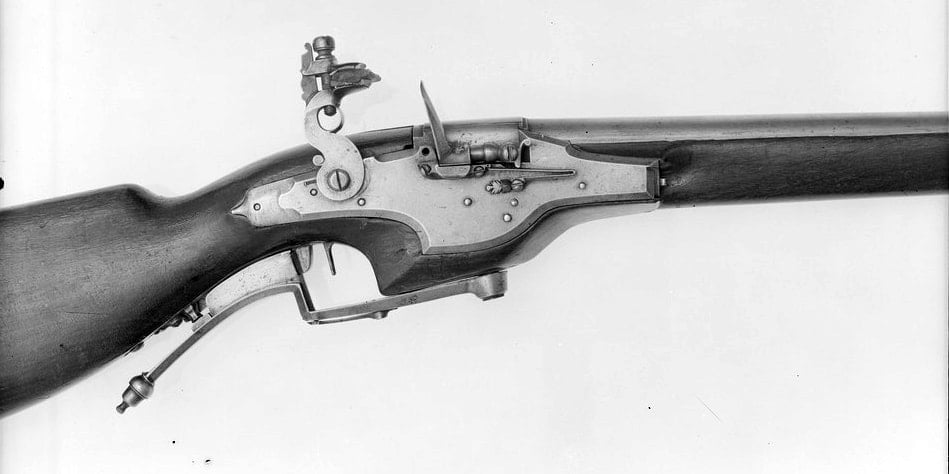The first repeating rifle used in combat by a military force was a flintlock system developed by the Kalthoff brothers. It was adopted in the 1640s by the Danish Royal Guard, who purchased a bit more than 100 of the guns, and used them successfully in the Siege of Copenhagen in 1659. The Kalthoff is a .54 caliber flintlock rifle with a magazine of 30 balls under the barrel and a powder storage compartment in the buttstock. A lever under the action is rotated forward 180 degrees and then back to completely reload the rifle – this action loads a ball into the chamber, seats it fully in place, loads powder behind it, primes the pan, cocks the hammer, and closes the frizzen. This was an amazing amount of firepower in the mid-1600s, and the mechanism in the gun is brilliant.
The Kalthoff brothers (Peter, Mathias, Caspar, Henrik, and William) spread out across Europe working for many royal courts although it was in Denmark where their gun saw the most substantial military use. The system would lead to other repeating flintlock designs like the Lorenzoni, but these did not really meet the quality of the original Kalthoffs (in my opinion). However, the system was very expensive to make and rather fragile to use. By 1696 the Danes had taken them out of service in favor of simpler and more durable designs.
Removed by mod
Watch the video. The powder charge used in every shot is carried by a small chamber in the rotating guard. The powder reserve is completely disconnected from any part of the firing mechanism.
I believe you, I’m just not sure I believe you a holding-a-grenade-next-to-my-face-while-shooting amount.
If only you could say, watch a video where someone demonstrates how the firearm works.
It’s interesting that we have examples like this but yet some people claim that the founders of the United States never could have imagined the firepower of semi automatic firearms that are protected by the 2nd Amendment today
But all that aside its an incredibly cool design
While revolutionary at the time, thris is still more in line with a bolt action than a semi auto. And other than some potential rich collectors these would have been in the hands of the military, not civilians due to their cost and complexity. Notice that they also switched back due to their lack of reliability. These clearly didn’t work quite as well as people hoped.
That’s fair. Even if the design wasn’t entirely reliable you could see the potential of future designs.
Civilians have always been near the cutting edge of firearms stuff. In the civil war the Henry rifle was bought by soldiers to great effect. These days even budget ARs have free floated handguards with m lok attachment points, compared to the proven but dated design of M4A1s that most conventional forces use. We can do the experimentation that the military can’t afford to do at scale.
Sure, I’d go a step further though and argue that even if the founding fathers could conceive of a modern high-rate-of-fire firearm, they probably never expected then to be readily available to the masses though, only the well to do. The question of “what they envisioned” is not just a technical puzzle, but a social one too.
When you’re talking about god given rights I think the idea is that social status is irrelevant, at least in intent
Yeah, it definitely wasn’t a given for the founders. There was a whole lot of talk about only letting landowners vote at one point.
Thomas Jefferson even invented a term for a specific type of political elite that he thought should be in power.
Look at the treatment of black people. Article one, section two of the Constitution counted enslaved people as three-fifths of a person when determining congressional representation. Rights were definitely different based on who you are.
Heck, they still are… There are plenty of examples of modern subcultures with different rights. Gay marriage, etc.
From my quick read of the Natual Aristocracy page it sounds like he describes two kinds of people, those who got power and privelage through personal drive and action (a person who starts a company, invents something, leads an organization, advances research) and those who inherit the status and money with little effort on their part (decendents of royalty, trust fund babies etc).
So the idea of finding people with talent and passion at all levels of society and helping them succeed through higher education isn’t far fetched. It sounds a lot like how modern scholarships work to me. Yes their idea of “equality” is not the same but we’ve come a long way.
In that very article they quote him saying that gunpowder has armed both the weak and the strong. In context he’s referring to the desire for physical strength/fitness but that can also go for cultural strength as well. The second amendment, here and now, allows the “modern subcultures” you mentioned to have firearms same as any other citizen.
Yeah his mindset didn’t include women or people of color but it doesn’t make the core idea invalid, which is that not everyone should have power, even if they are rich, but that everyone should have rights.
“Yeah his mindset didn’t include women or people of color but it doesn’t make the core idea invalid”
I’m not sure how you could think that the founding fathers could exclude people and still mean everyone. “Everyone” specifically means not excluding anyone.
So… a weapon from a hundred years before their time that had not made it anywhere near mass production is a sign that it is the future?
It can be. They had electric vehicles in mines in the 30s and a few decades later here we are. The problem was the power source. Those vehicles were run with ridiculously long extension cords.
For guns the capacity was there, the problem was managing powder, caps and bullets. Cartridges came around and rapid fire was now easily achievable
Thanks for sharing, this is one of the coolest boom sticks I’ve ever seent.



